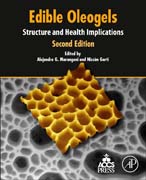
Edible Oleogels: Structure and Health Implications
Marangoni, Alejandro G.
Garti, Nissim
Edible Oleogels, Second Edition, presents a novel strategy to eliminate trans fats from our diets and avoid excessive amounts of saturated fat by structuring oil to make it behave like crystalline fat and identifies evidence on how to develop trans fat free, low saturate functional shortenings for the food industry that could make a major impact on the health characteristics of the foods we consume. In an effort to provide alternatives to trans and saturated fats, scientists have been busy modifying the physical properties of oils to resemble those of fats. In this fashion, many food products requiring a specific texture and rheology can be made with these novel oil-based materials without causing significant changes to final product quality. The major approach to form these materials is to incorporate specific molecules (polymers, amphiphiles, waxes) into the oil components that will alter the physical properties of the oil so that its fluidity will decrease and the rheological properties will be similar to those of fats. These new oilbased materials are referred to as oil gels, or oleogels, and this emerging technology is the focus of many scientific investigations geared toward helping decrease the incidence of obesity and cardiovascular disease. This book will be of interest to those in product development as well as those working to understand the role of trans and saturated fats in health and nutrition. Presents emerging science on beta gels using natural triglycerides, ethylcellulose oleogels, and oleotropic liquid crystalsSuggests a novel strategy to eliminate trans fats from our diets and avoid excessive amounts of saturated fat by structuring oil to make it behave like crystalline fatReviews the structuring of edible oils to form new mesoscale and nanoscale structures, including nanofibers, mesophases, and functionalized crystals and crystalline particlesIdentifies evidence on how to develop trans fat free, low saturate functional shortenings for the food industry that could make a major impact on the health characteristics of the foods we consume INDICE: 1. An Overview of the Past, Present, and Future of Organogels2. Novel Strategies for Nanostructuring Liquid Oils into Functional Fats3. Edible Oil Organogels Based on Self-assembled,B-sitosterol + Y-oryzanol Tubules4. Vegetable Oil-Based Ricinelaidic Acid Organogels - Phase Behavior, Microstructure and Rheology5. Hydroxystearic Acid Oleogels6. Candelilla Wax as an Organogelator for Vegetable Oils - An Alternative to Develop trans-free Products for the Food Industry7. Wax Organogels8. Monoglycerides in Oils9. Physical Properties of B-fat Gel Made of Fully-hydrogenated Rapeseed Oil and Vegetable Oils10. Ceramide Oleogels11. Oleogels Based on Non-lamellar Lyotropic Liquid Crystalline Structures for Food Applications12. Protein-templated Oil Gels and Powders13. Ethylcellulose Oleogels14. Long chain alcohols oleogels15. SOSA oleogels16. Shellac oloegels17. Human Clinical Study on 12-hydroxystearic Acid Oleogel Ingestion18. Human Clinical Study on Ethylcellulose Oleogel Ingestion
- ISBN: 978-0-12-814270-7
- Editorial: Academic Press and AOCS Press
- Encuadernacion: Rústica
- Páginas: 464
- Fecha Publicación: 20/06/2018
- Nº Volúmenes: 1
- Idioma: Inglés
